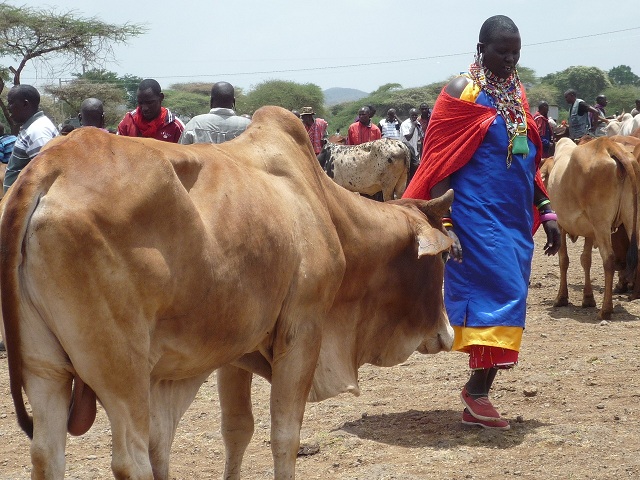Farming Beef in Kenya: BY DR. MOSES OLUM: The country boasts an estimated 14 million beef cattle, making beef farming in Kenya on of the major forms of agri-business. This population is majorly made up of local and indigenous breeds and three quarters of them in the hands of pastoralists in ASAL areas.
With this population, Kenya being a ‘nyama choma’ nation, every Kenyan consumes an average 15-16 kg of red meat annually.
Picture this on beef farming in Kenya: A Maasai herder could have a herd of 200 animals, keep them locally for 5 to 10 years with attachment and not sell them to restock until a drought comes and wipes out over 70 per cent of the stock. This leaves a once rich man from beef farming in Kenya poor and distraught. All this time, his animals will weigh between 200 – 400 kilos; being borans, these animals have the potential to weigh over 600 kilos for males. This is where a money minting venture in beef farming in Kenya called feed-lotting comes in.
An example of a livestock market. Beef farming in Kenya is under utilized.
Feedlotting is a technical word for confining animals, mainly beef and feeding them on the best food ratios to be ready for the market in the shortest time possible. The duration can vary from 60 – 120 days. During feedlotting, animals are fed for maximum weight gain. The diet is majorly high in carbohydrate, sufficient proteins and optimum mineral salts. During this period, these animals depending on age and nutrition can gain between 50 – 200 kilos.
Feed can be compounded from locally available products such as maize grains, cotton or sunflower seed cakes and mineral premixes available from various manufacturers. Formulation of such diet depends on the cow’s nutrient requirements for a desired level of performance, the nutrient content of feeds and the price and availability of the raw materials.
Livestock markets happen weekly in livestock keeping communities where beef farming in Kenya is common. And with the recurrent droughts, prices of animals are on an all time low. This has relatively kept the cost of cattle weighing between 250 to 350 kilos at an all time low, averagely Sh25,000. Such animals have achieved slaughter age of 2 or 3 years but due to poor nutrition and husbandry, they’re underweight.
The game changer in this is only optimal nutrition to get these animals to get to between 450 – 600 kilos in three months when they can cost between Sh60,000 to Sh80,000 depending on your target market. This would look farfetched and some may think the cattle are being fed on hormones or growth promoters.
On introducing cattle to a feedlot, the roughage content has to be higher than the grain. Over time, grain must be increased slowly and roughage correspondingly decreased so that the gastro-intestinal tract has an opportunity to adapt to the increased grain (starch/concentrates) content. All these have to undergo prior processing to improve their nutritive value. You can buy commercial feedlot feed as on way of having profitable beef farming in Kenya.
Farming Beef in Kenya: The country currently mainly exports animal products to the Middle East.
For this sort of beef farming in Kenya yo succeed, it is worth noting that, the requisite weight gain cannot be achieved without ensuring cattle entering a feedlot system are free from disease, and other stress factors. This calls for appropriate infrastructure and an investment on preventive care. This is the time to ensure cattle are vaccinated against diseases of concern in a given geographical area, dewormed and all biosecurity measures put in place. Innovative Kenyans with the requisite capital are already reaping profits from feedlot systems.
Farming Beef in Kenya success example
One remarkable example of successful beef farming in Kenya is a team of investors who have put up a feed lot on a 2 acre plot in Chaka, Nyeri County. They invested in good infrastructure, disease control, feed mill and got into business – Pioneer Feedlot. Dr Gakuo, the managing partner says he travels to various livestock markets where he buys cattle for between Sh18,000 to Sh30,000 depending on the breed. Most of the animals are emaciated or underweight, at the time of buying.
After three months of intensive feeding, he sells an animal at between Sh60,000 and Sh90,000. With capacity of handling up to 800 cattle per batch, the ranch is in good business with economies of scale. In this spirit and with evidence that feedlotting is a profitable venture, pastoralist counties of Marsabit, Isiolo and Laikipia have formed a consortium to venture into this enterprise. Like any business venture, it is not all rosy. Challenges in this form of beef farming in Kenya include a large capital outlay needed, sourcing of animals, diseases and high feed costs.









This wonderful indicator is an example to follow and make Kenya self sufficient in beef. TADs will be easily dealt with. Thank you author for info.
thanks for that article, can i get a vet or some one who can advice me on feedlot in limuru, kiambu county. my email is [email protected]